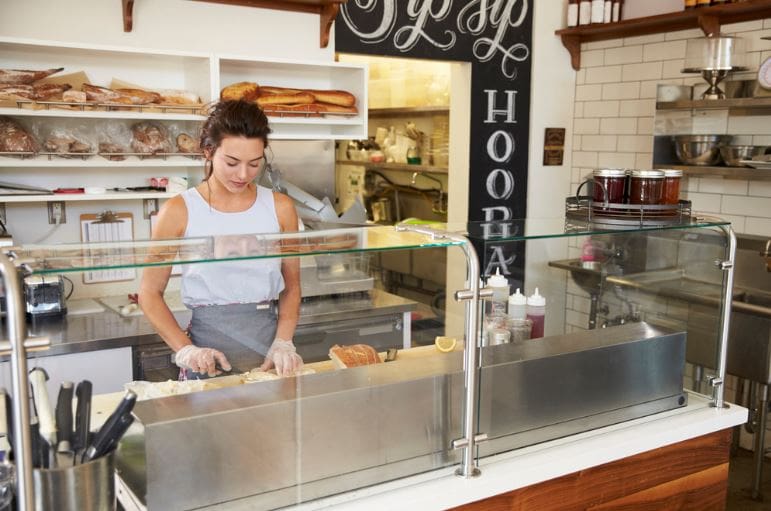Have you seen delis and sandwich shops with a line going out the door? Ever wanted to own your own sandwich shop and cash in on one of America’s favorite foods?
If you love sandwiches but don’t know how to get into the business, we’ve got you covered.
To help you get started, we spoke with Kevin McHenry of Cricca’s Italian Deli & Subs in Woodland Hills, California.
His shop is so successful that he paid off his investment in four years, and it now boasts a 4.8 out of 5 rating on Google with over 190 reviews! Kevin went “all-in” on a sandwich shop and is now reaping the benefits of his hard work.
Follow our definitive guide and Kevin’s expert advice, and you too can start cashing-in on your own successful sandwich shop!
If you don’t have a big starting budget then you can always buy an existing and established shop.
1. Make a Plan! Calculate the Startup Costs and Operating Costs
Before opening a sandwich shop, it’s important calculate your initial and ongoing costs of operation as part of a business plan. Like any new business, it isn’t cheap if you want to set up for success. Fortunately, there are options in this branch of the food service industry.
How Much Does It Cost to Open a Sandwich Shop?
Sandwich shop opening costs range from $60,000 (in Iowa) to over $1.5 Million based on the location and type business. Also, whether you open a franchise or an independent business will factor into your grand total.
We’ll explore those options in the next section, but first, here is a list of the initial costs:
- Inventory (Opening)
- Equipment (Kitchen Appliances, POS System, Refrigerators, etc…)
- Location (Deposit)
- Business Registration and Licenses
- Inspections
- Marketing
- Business Attorney
- Accountant
This is a list of the ongoing expenses you can expect in a sandwich shop:
- Employees
- Inventory
- Maintenance and Repair
- Location (rent and lease)
- Marketing and Advertising
Kevin explained,
What Equipment Do I need to Open a Sandwich Shop?

Sandwich shops require a lot of equipment to operate, and it’s up to business owners to find local restaurant suppliers that can equip their location for success. You can buy or lease equipment based on the supplier, and you must factor it into your initial and ongoing costs.
A great resource to find a local supplier is through your state’s restaurant association that is affiliated with the National Restaurant Association.
However, if you’re opening a franchise, you must go through their recommended suppliers.
Here’s a shortlist of equipment needed for opening a sub shop:
- Commercial Refrigerators (Reach-in, Glass-Door Reach-in for beverages, and possibly a Walk-In)
- Preparation Tables (and refrigerated ones)
- Sinks, Dishwasher, and Cleaning Equipment
- Meat, Cheese, Bread, and Vegetable Slicers (Yes, there’s a different machine for each.)
- Food Processor
- Scales
- Commercial Oven and Microwave
- Sandwich Press and/or Griddle
- Kitchen Utensils (Knives, cutting boards, tongs, etc..)
- Ice and Beverage Machine
- Customer Utensil and Condiment Caddies (A caddy is a display that holds these items.)
- Furnishings
Independent business owners have an advantage with equipment as they can purchase used equipment to reduce startup costs. However, if you open a franchise, these decisions (and their costs) are made for you.
2. Work in a Deli or in the Food Service Industry

For many of us, our first job was as a server, bartender, or cashier. We remember sweating bullets and delivering orders with a smile to happy and sometimes unhappy customers. Running a deli is no different.
If you have no experience in food service, you should get some before investing your hard-earned money into a new business. It is essential to know the style and pace of the industry.
Kevin stated,
“My first job was working in a deli. I knew from that day I always wanted to have my own Deli.”
However, not everyone has worked in a deli or knew they wanted to own one from the start. If you have no experience, you would benefit from a job as a food and beverage server or as a food service manager.
The good news is that the food service industry is always hiring. With a college degree, it’s not unheard of for sandwich chains to hire managers with little to no experience. Without one, you can still learn the business from the bottom up.
Here are some of the top sandwich chains in the U.S.:
- Jimmy John’s
- Subway
- Jason’s Deli
- Jersey Mike’s
- Firehouse Subs
- McAlister’s Deli
- Arby’s
- Panera Bread
3. Should I Open a Franchise or an Independent Sandwich Shop?
As stated, opening a franchise or an independent location is a big factor in your initial opening cost, and there’s no clear-cut answer to this question. But we can provide the pros and cons of both situations, so you’re equipped to make a decision that’s right for your small business.

Franchise Pros
- Pre-set business model with a proven track record of success
- Name recognition at opening
- Easier to obtain a business loan
- Less experience is necessary to run the business
- Sometimes cheaper inventory and equipment (Franchises have established relationships with suppliers).
Franchise Cons
- Higher initial investment based on the franchise (see below)
- No creativity with recipes or ingredients
- Shared financial information (Franchises require you to share financials for audits and marketing).
- No control of advertising or promotions
- Prices set by franchisor
Independent Pros
- Complete and total control of menu, marketing, and pricing.
- No profit (or financial information) sharing
- Possibly cheaper equipment if you have existing knowledge or relationships
- Creativity and innovation opportunities are limitless
- Lower initial investment (usually)
Independent Cons
- No support or training; everything falls on you
- Harder to obtain financing
- No name recognition unless you purchase an existing independent business
- Experience is necessary or, at the very least, highly recommended
- Inventory (food cost) is more expensive
Conclusion: Franchise vs Independent Business
There’s a lot to think about when weighing out the question of franchise vs independent deli. With an independent business, it’s important to note the expenses of your inventory, as that will be the X-factor that makes you stand out above a franchise.
As Kevin explained, the #1 tip to having a successful sandwich shop is:
However, if you lack experience or business knowledge, a pre-existing model may be the best path to opening a deli. Here are the franchise costs associated with the top sandwich shop franchises we listed above:
Note: These costs are averages of franchise fees plus all additional costs (construction, supplies, etc…). The cost will vary by location.
- Jimmy John’s – $350,000
- Subway – $150,000
- Jason’s Deli – $1 Million
- Jersey Mike’s – $350,000
- Firehouse Subs – $350,000
- McAlister’s Deli – $1 Million
- Arby’s – $1 Million
4. Know the Risks of Opening a Sandwich Shop

Let’s be honest: while the failure rate of restaurants is largely overexaggerated, there are a lot of sandwich shops out there. Subway locations outnumber McDonald’s by nearly 10,000 in the U.S., and all the other chains and independent sandwich shops number in the tens of thousands.
We don’t mention these statistics to scare you, but it’s important to know the risks of opening a sandwich shop. Many small business owners risk their life savings every day in the U.S. To be in the success column in this industry, it will take hard work and dedication.
In our interview, we asked Kevin what he attributes to his success:
With every small business, there is risk, but there are also ways to reduce those risks. Nothing is better than excellent work ethic and experience. If you’re starting a sandwich shop and have no experience, minimize your risk and gain experience or work with a mentor.
5. Find a Location

We can provide information on things like costs, equipment, and risks, but it’s all for nothing without the right location. If you want to know how to open a sandwich shop business, then you need to know how to pick a restaurant business location.
It’s a top factor in determining the initial cost of your business. You may want a spot in an area with a heavy population and high-traffic, but you’ll have to pay for it. For smaller restaurants like sandwich shops, it’s beneficial to find locations with a blend of traffic and value.
That’s why market research is so important for determining factors like:
- Demographics
- Competition
- Population
- Accessibility and Visibility
You can find a lot of this information through the U.S. Census Bureau, and it will help you assess locations that suit your business needs.
Pre-existing Business Location
Also, it may be in your best interest to find a location with a pre-existing business. Opening a new location can be tough even for someone with experience in the industry. Buying an existing location can reduce your startup costs, and if you’re lucky, you could find a mentor willing to help you get started.
Even with Kevin’s experience in the deli industry, he opted to purchase a pre-existing business because the location already had a solid base and great traffic.
“One of the guys I met at that Deli, my very first job, is who I ended up buying the Deli from 40 years later.”
However, if you do plan to purchase another business, be sure to explore our article on How to Value a Business so you don’t pay a penny more than what it’s worth.
6. Registration

Now that you’ve made some hard decisions, it’s time to choose your business structure and register your business at the state and federal levels. Fortunately, starting a deli is a little easier than many other businesses out there in terms of permits and licenses.
Work with an accountant or business attorney to help determine which business structure is best for you (sole proprietorship, limited partnership, limited liability company, or corporation). Most sandwich shops operating as a small business opt to form an LLC to maximize their tax benefits and financial risk.
It’s also necessary to choose a name for your business at this point. Just know that many restaurant business names do not match the name that’s on the store front. This is the case if you invest in a franchise. Even Taco Bell’s business name is Yum! Brands, Inc.
7. Sandwich Shop Business Plan and Funding
The most important factor in learning how to open a small sandwich shop is knowing how to put together a business plan. Many owners fail in the food service industry because they go into a new business relying only on gut experience instead of a plan.
A business plan in the food industry is a little different from other industries and should include:
- Executive Summary
- Company Description
- Market Analysis
- Menu
- Employees (Management Team)
- Location and Design of the Location (Layout)
- Market Overview
- Marketing Strategy
If you need help developing a plan, the U.S. Small Business Administration has tons of resources for putting together a great business plan.
Funding Your Sandwich Shop
We said at the beginning that Kevin was “all-in” on his deli, and he meant it. Sandwich shops are not a cheap investment, and you will also have to figure out a way to fund your new business.
If you don’t have out-of-pocket funds like Kevin, you can apply for a small business loan through the SBA or a conventional loan from a bank. It may also be possible to hedge your funds with other investors who believe in your vision and business plan.
Here are some other options for getting a loan for your business:
- Microloans
- Vendor Financing
- Non-Bank Online Loan
- Business Credit Card
Regardless of how you get the money, your business plan will be the #1 tool and resource that helps you secure those funds and pay them back through the success of your shop.
8. Financial Goals
 If you want to pay back your loans or recoup your funding, it’s important to set some financial goals for your business. Using your business plan, you’ll be able to determine realistic goals that will map out a plan to pay all of your bills.
If you want to pay back your loans or recoup your funding, it’s important to set some financial goals for your business. Using your business plan, you’ll be able to determine realistic goals that will map out a plan to pay all of your bills.
The menu section of your business plan will be key in helping set these goals. The cost of the food vs the price at which you sell it is the baseline financial determiner of any sandwich shop. And your menu determines that margin.
If you’re buying an existing business, be sure to carefully review the menu (food cost) section of any business plan.
How much does a Sandwich Shop Make a Year?
To set these financial goals, it’s good to have a reference point for comparison. On average, sandwich shops in large cities in high traffic areas net from $120k to $300k per year. However, the factors are determined by brand, culture, and location.
For example, a deli in Ann Arbor, Michigan that has been in business since 1982 is now netting over $50 million per year with only one location. On the other hand, over 1,000 Subway locations closed in 2018. Ultimately, it will be you, the business owner, who determines the success of your business.
Are Delis Profitable?
Regarding profits, Kevin said,
“You want to try to hit at 30 percent but that is not always doable. One thing is we pay for top of the line products. You try to do at least 30%, but people are not going to pay $18 for a turkey sandwich either.”
Delis are a profitable venture if you make sure that your pricing is correct and you keep your payroll in check. Profitability reflects a solid business plan and clear financial goals that are set before you open the store. If you set everything up for success, then you too can pay off your store in 4 years just like Kevin.
9. Marketing

The marketing plan for any business is important, but marketing for a business in the food industry is what you live or die on. Think about all the food-oriented advertisements you see on television. I can still hear that stupid “$5 footlong” song playing in my head, and that’s the support you receive from partnering in a franchise.
Small business owners have to get creative to drive customers into their store. The options are endless, but here are a few ideas to get you started:
- Contests
- Free Samples
- Food Classes
- Loyalty Programs (Remember all of those stamp and punch card programs from sandwich shops?)
- Email and Social Media lists
- Community Outreach
On marketing, Kevin explained,
Partnering with Online Ordering and Food Delivery Services
 With smartphones, apps, and all of the other technology of the 21st century, it may be essential for your sandwich shop to partner with an online ordering and/or food delivery service. It’s a great form of marketing and can add a lot of extra revenue to your business.
With smartphones, apps, and all of the other technology of the 21st century, it may be essential for your sandwich shop to partner with an online ordering and/or food delivery service. It’s a great form of marketing and can add a lot of extra revenue to your business.
When Kevin took over his deli, he was adamant that they didn’t change the product, but that didn’t mean he refused to update the business model. He said,
Here’s a list of the top online ordering and food delivery services, so you can incorporate it into your business plan and start your business with a 21st century model:
- GrubHub
- DoorDash
- Uber Eats
- Postmates
- ChowNow
10. Customer Experience: POS, Employees, and Quality
Customers are the lifeblood of the food industry and your most important marketing tool is their word-of-mouth. That’s why it’s so important to provide an amazing experience for first-time visitors of a new business. After all, they’re the ones who will post about your new sandwich shop on Yelp, Google, and Facebook.
Creating a good customer experience in the food service industry is reliant upon three things: the POS (point of sale) system, your employees, and the quality of your food.
POS

As Kevin explained in the previous section, he added a POS (point of sale) system to his new business to update it to a 21st century model.
A solid POS system allows your employees (or you!) to input orders quickly and correctly. It’s a computer program that contains your entire menu and all of the additional elements you can add or take away from a menu item.
Think of it this way:
You need a system so your cashier can tell the sandwich maker that a customer ordered a large turkey sub with lettuce, tomato, pickles, swiss cheese, no mayonnaise, and extra Dijon mustard. And the customer also wanted chips and a large beverage.
These systems are essential for ensuring that customers receive their order in a timely manner and that the order is exactly what they ordered. Speed and efficiency are key for customer service.
A POS system saves you from having to re-make food because an order was incorrect. It also ensures that employees charge for every item or menu addition that was ordered. This is a key factor in maximizing revenue and profits in the food service business.
POS systems are so important that franchises spend millions to develop their own in-house software. But if you’re an independent business, be sure to do your research and invest heavily in a solid system with warranty, maintenance, and support plans. Here are some of the top POS systems to get you started:
- Poster
- Shopkeep
- Upserve
- Toast
- Clover
Employees
We asked Kevin what his biggest struggle was with his business and he said,
Employees are one of the most essential elements in the food industry besides the actual menu. They’re the key to providing your customers with an outstanding experience through customer service. And many times, that great service is the reason customers come back.
Here are a few key strategies you can use to make sure you’re hiring the best of the best:
- Make it easy for people to apply. You’ll find more applicants which gives a better statistical chance of finding a great one.
- Give a clear job description, title and wages and clearly describe responsibilities.
- Instead of attracting unemployed workers, try to attract workers looking for a better job
- Train yourself or managers at interviewing.
- Talk about your goals and see how a potential employee responds
Quality
 Customers always want a quality product. In fact, many customers will overlook slight lapses in service if the food is outstanding. So if you want to know how to start a sandwich shop, you better know how to deliver high-quality sandwiches.
Customers always want a quality product. In fact, many customers will overlook slight lapses in service if the food is outstanding. So if you want to know how to start a sandwich shop, you better know how to deliver high-quality sandwiches.
We asked Kevin about the main key to growing a sandwich shop business and he said,
Take this advice and provide fresh, high-quality ingredients. Create a sandwich that customers will think about next time they’re hungry.
Let’s Make Some Sandwiches!
With those last three elements, you now know how to open a sandwich shop. Sandwich shops are a saturated market, but with a good business plan, a great location, and a solid menu, you’ll be ready to serve your first customers in no time.
We’ll leave you with three final tips from Kevin:
Do you have any experience with running a business in the food service industry? Tell us about it!



